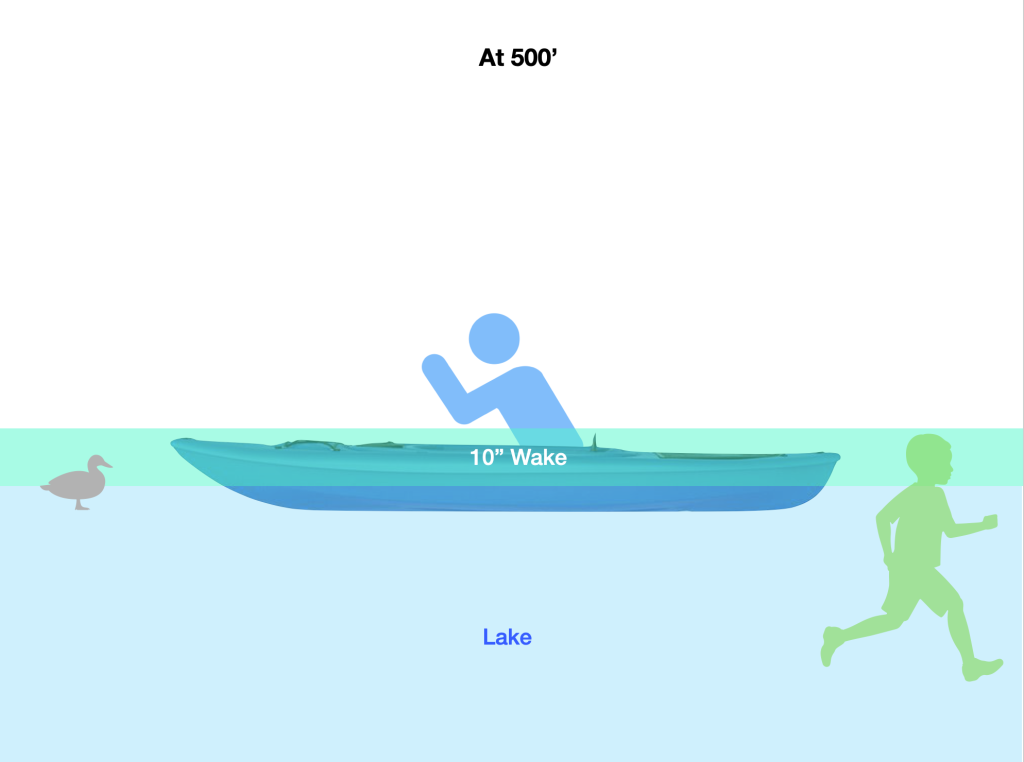How far does it take for a wake surfer’s wake to dissipate to a safe height?
This is a question we should have been asking all along. An interesting source of information that may help us answer this important question comes from the industry-sponsored experimental study conducted by Clifford Goudey and his associates on a lake in Florida. They ran a wakesurf boat across the water and measured the heights of the resulting wakes at various distances. This study, because it was funded by the watersports industry, and because its conclusions did not seem supported by its data, is often discounted and not fully considered. However, the raw data collected by the researchers may provide insights useful to our current discussions.
The graph below was published by Goudey to report the data he collected. The plot most relevant to the proposed rule is that of the surfer’s wake height in deep water, shown in yellow near the top of the illustration. The red arrow in the upper left shows that the wake was measured at about 26.5” right at the boat. (Evidently this was not a very powerful wakeboat; today’s wakeboats advertise wakes of 36″ and 48″.)
The blue arrow shows the height of the wake 325 feet from the boat, which is the furthest point measured in the study. At this distance the wake measured 14” high.

If we conservatively extrapolate Goudey’s measurements along a straight line, we see that the predicted height of the wake at 500 feet — the distance proposed by DEC’s rule — has fallen to about 10”, shown by the magenta arrow. This is a dangerous wake for a swimmer, angler, kayaker, or nesting loon. I have never seen a wave this high on Lake Elmore. To get down to a height of 5” — still difficult for most normal, traditional lake users — one would need to be more than 1000 feet from the surf boat, as shown by the green arrow.

Let’s look more closely at the effects of a 10” wake. The illustration below shows a kayaker, a waterfowl, and a swimmer treading water. The blue water is at normal lake height. The green water shows the effect of a 10” wake. This wake would swamp the duck, submerge the swimmer, and overturn the kayak. This wake would preclude most normal and traditional lake users from their pursuits.

An offset of 500 feet for wakesurfing does not protect normal and traditional users of our lakes and ponds. 500 feet is not enough. At least 1000 feet are needed to reduce a surfer’s wake to a safe level.
And even a 4″ wake — the height left by a wake surfer 1000 feet away, or by a normal boat 200 feet away — is not a common or pleasant experience on a small Vermont lake. In fact it would take a 15-mph wind blowing for an hour to produce such wave on Lake Elmore. This seldom happens — the average wind speed here is 4 mph — and when it does, everyone skedaddles off the lake.
Remember that this analysis is based on data provided by the wakesports industry itself, and comes from an older-model wakeboat much less powerful than those being sold today, with a wake about half as high as today’s boats. If we were to repeat the experiment with a new surf boat making a 48″ wake, the distance needed for wake dissipation and the mitigation of adverse impacts would be much greater — beyond 1,000 feet from shore.
You may view an narrated and animated version of this newsletter here.
